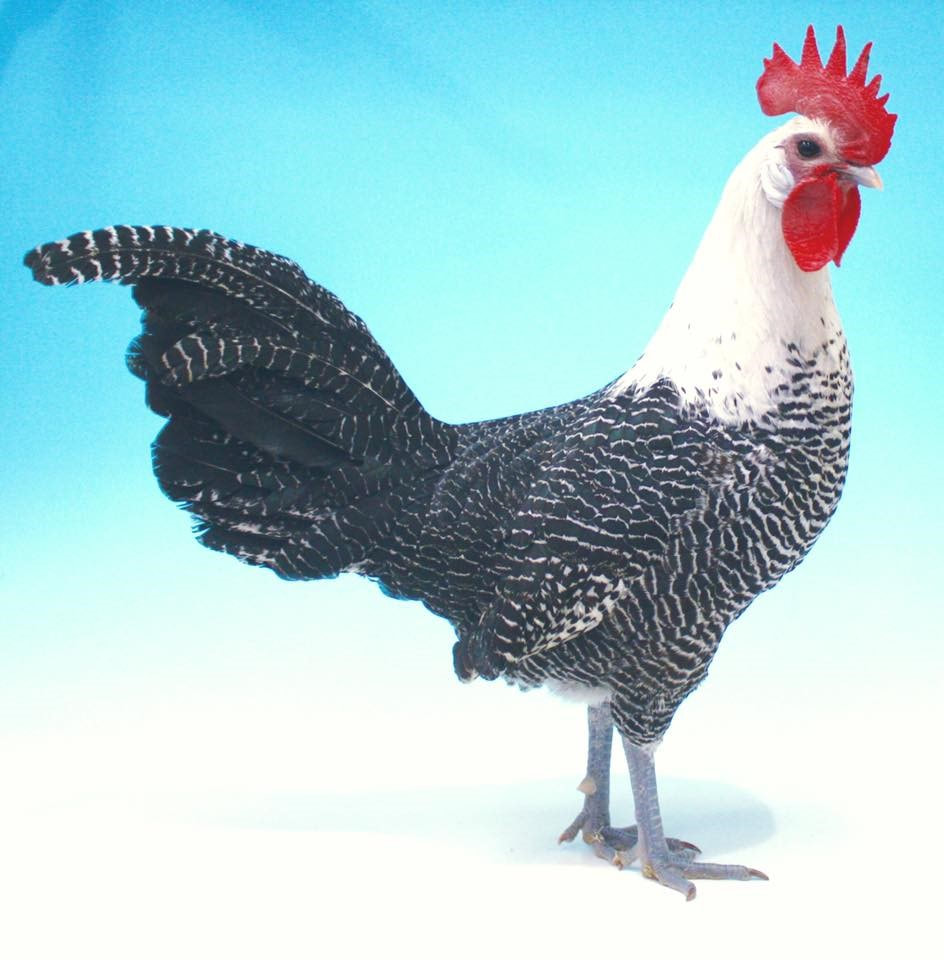The Campine (pronounced kam-peen) originated in the northern part of Belgium around Antwerp. It is closely related to the Brakel (also Belgium), Chaamse Hoen (The Netherlands) and Hergines fowl (northern France). Most Campine males bred in Belgium before 1900 had normal cock feathering, although hen-feathered males appeared occasionally. The difference between Brakels and Campines then was in build and weight, the Campines being slimmer.
British poultry expert Edward Brown wrote about Campines in 1897, soon leading to the first importation by Thomas Braken of Lancaster. A Campine Club was formed here about 1900. The Club members had heard about the hen-feathered males, but did not have any at first. They were keen to adopt them as their standard male to avoid the complications of double mating experienced by breeders of Pencilled Hamburghs. The first hen-feathered male in the UK, a Silver from eggs imported from Belgium, won at several shows in 1904. Sons of this bird were spread around club members, some of whom crossed them with Gold females to produce hen-feathered Gold males by 1911. Rosecombed Campines briefly appeared in the 1920s and '30s. Campine bantams have appeared from time to time since the 1950s.
General characteristics: male
Carriage: Alert and graceful.
Type: Body broad, close and compact. Back rather long, narrowing to the tail. Breast full and round. Wings large and neatly tucked. Tail carried fairly high and well spread. Campine males are hen feathered, without sickles or pointed neck and saddle hackles. The top two tail feathers slightly curved.
Head: Moderately long, deep, and inclined to width. Beak rather short. Eyes prominent. Comb single, upright, of medium size, evenly serrated, the back carried well out and clear of neck, free from excrescences. Face smooth. Earlobes inclined to almond shape, medium size, free from wrinkles. Wattles long and fine.
Neck: Moderately long and well covered with hackle feathers. The formation of the neck feathers in the Campine is called the cape.
Legs and feet: Legs moderately long. Shanks and feet free from feathers. Toes, four, slender and well spread.
Female
With the exception of the single comb which falls gracefully over one side of the face, the general characteristics are similar to those of the male, allowing for the natural sexual differences.
BANTAM
Campine bantams should follow exactly the standard for the large fowl.
British poultry expert Edward Brown wrote about Campines in 1897, soon leading to the first importation by Thomas Braken of Lancaster. A Campine Club was formed here about 1900. The Club members had heard about the hen-feathered males, but did not have any at first. They were keen to adopt them as their standard male to avoid the complications of double mating experienced by breeders of Pencilled Hamburghs. The first hen-feathered male in the UK, a Silver from eggs imported from Belgium, won at several shows in 1904. Sons of this bird were spread around club members, some of whom crossed them with Gold females to produce hen-feathered Gold males by 1911. Rosecombed Campines briefly appeared in the 1920s and '30s. Campine bantams have appeared from time to time since the 1950s.
General characteristics: male
Carriage: Alert and graceful.
Type: Body broad, close and compact. Back rather long, narrowing to the tail. Breast full and round. Wings large and neatly tucked. Tail carried fairly high and well spread. Campine males are hen feathered, without sickles or pointed neck and saddle hackles. The top two tail feathers slightly curved.
Head: Moderately long, deep, and inclined to width. Beak rather short. Eyes prominent. Comb single, upright, of medium size, evenly serrated, the back carried well out and clear of neck, free from excrescences. Face smooth. Earlobes inclined to almond shape, medium size, free from wrinkles. Wattles long and fine.
Neck: Moderately long and well covered with hackle feathers. The formation of the neck feathers in the Campine is called the cape.
Legs and feet: Legs moderately long. Shanks and feet free from feathers. Toes, four, slender and well spread.
Female
With the exception of the single comb which falls gracefully over one side of the face, the general characteristics are similar to those of the male, allowing for the natural sexual differences.
BANTAM
Campine bantams should follow exactly the standard for the large fowl.
Please contact the breed registrar for more information - [email protected]


